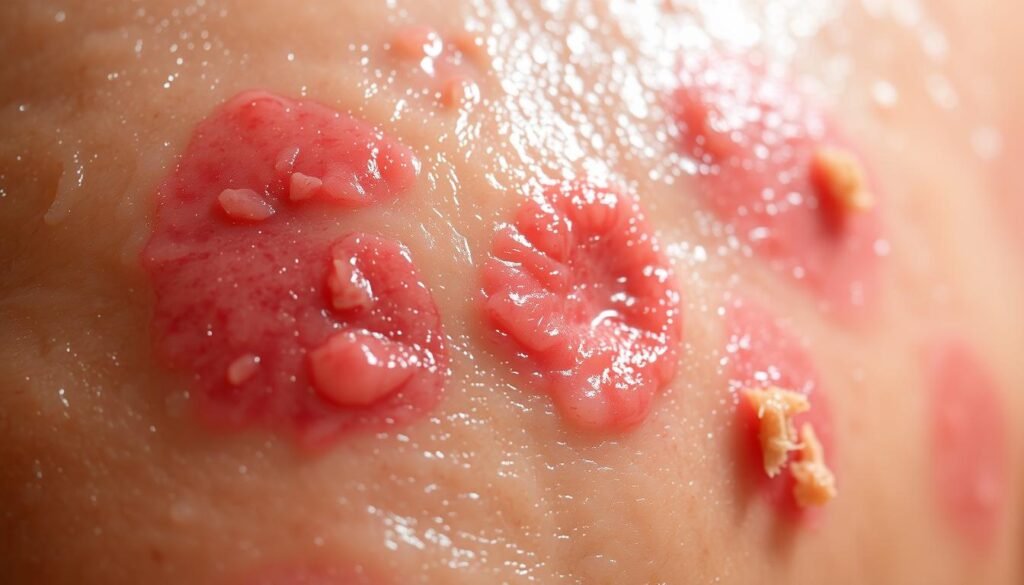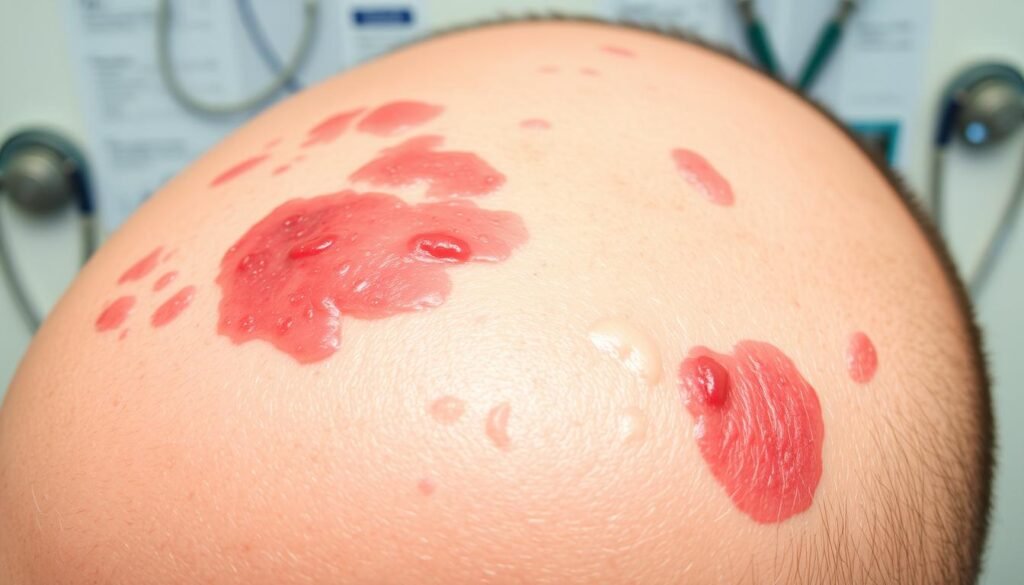Seborrheic dermatitis touches 3 to 10 out of every 100 people at some stage. This condition is most common in adults aged 30 to 60. It’s crucial to understand the connection between too much oil production and this skin issue. Knowing this helps people find the right treatments. They can also adjust how they care for their skin.
Key Takeaways
- Seborrheic dermatitis affects 3-10% of the population at some point.
- This skin condition is most prevalent among adults between 30-60 years.
- Men are generally more prone to experience seborrheic dermatitis than women.
- Managing oily skin is crucial for improving treatments of seborrheic dermatitis.
- Various lifestyle changes and skincare routines can alleviate symptoms effectively.
- Resulting from an inflammatory reaction to Malassezia yeast, excess oil is a primary trigger.
Understanding Excess Oil Production
Excess oil production comes from overactive sebaceous glands. These glands are why skin feels oily. It especially impacts those with oily skin. Factors like genetics, hormonal changes, and environment play a part.
Puberty causes androgen levels to rise, which makes skin greasier. High humidity and hormones together can make oil issues worse. Diet and stress affect skin oil too.
People with too much oil may see an oily look and acne. This happens when oil and dead skin block pores. It’s important to manage oil to avoid skin problems like seborrheic dermatitis. This condition often hits areas rich in sebaceous glands, like the scalp.
To keep skin healthy, it’s best to use products meant for oily skin. Using the right cleansers and treatments helps control oil. Knowing how excess oil forms helps people choose the best skin care.
What is Seborrheic Dermatitis?
Seborrheic dermatitis is a long-term skin issue that mainly targets areas with lots of oil glands, like the scalp. It features oily yellowish scales, red skin, and often shows up as tough dandruff. People usually deal with scaly spots and hard-to-remove dandruff, causing discomfort.
Stress or cold, dry weather can make seborrheic dermatitis worse. Those with it might see their skin flake off or find oily patches with white or yellow scales on their face, around the nose, and chest.
An excess of Malassezia, a common skin yeast, contributes to seborrheic dermatitis. It can hit harder if you have certain health issues or are very stressed and tired. Knowing about this condition is key to control and avoid worse problems. For more details on how seborrheic dermatitis is different from dandruff, see this informative resource.
Symptoms of Seborrheic Dermatitis
Seborrheic dermatitis is a skin issue that shows up in oily parts of the body. It is known for causing red, swollen skin with flaky patches, much like dandruff. People with it often feel a strong urge to scratch because of itching.
This condition can appear on the scalp, face, behind the ears, and in skin folds. In babies, it’s called cradle cap and mostly affects the scalp.
What sets seborrheic dermatitis apart are the oily patches and slight redness. Sometimes, large plaques can form, making the discomfort worse. Recognizing these signs is key to managing the condition well. For extra details, look at this comprehensive resource.
| Symptoms | Description |
|---|---|
| Redness | Inflammation and irritation in affected areas, typically oily regions. |
| Flaking | Visible scales, often confused with common dandruff. |
| Itching | Intense itching that may lead to scratching and increased inflammation. |
| Greasy patches | Oily, shiny skin areas that may attract additional irritation. |
The Role of Oily Skin in Seborrheic Dermatitis
Oily skin plays a big role in seborrheic dermatitis. It creates the perfect space for Malassezia yeast. This yeast grows well in oily settings, leading to inflammatory skin reactions. People with oily skin often see their seborrheic dermatitis get worse. Thus, managing oily skin is key.
About 3 percent of people get seborrheic dermatitis. But, the number jumps to 85 percent among those with acquired immunodeficiency syndrome. Men, in particular, are more likely to get it. This is mainly because they have more active sebaceous glands. Clearly, there’s a strong link between oily skin and getting seborrheic dermatitis.
Hormone changes can make oiliness worse. This can make skin issues more severe. Problems often pop up around the nose, behind the ears, and the scalp. If you have HIV/AIDS, Parkinson’s disease, or cancer, you might get these skin issues more often.
Managing seborrheic dermatitis can involve medicated shampoos and creams. These attack the yeast. Taking care of oily skin helps stop and control flare-ups. So, it’s important to use treatments that target the problem.

Excess Oil Production and Seborrheic Dermatitis
Making too much oil is key in the start and worsening of seborrheic dermatitis. The scalp making too much sebum sets up a good place for Malassezia yeast to grow. This can lead to inflammation and the usual symptoms of seborrheic dermatitis. Knowing how these two things connect is vital for good skin health.
How They are Linked
Many things affect how much sebum is made, linking it to seborrheic dermatitis. Not cleaning the scalp well can cause a buildup, irritating the scalp and making more oil. Also, certain hair products, especially those with lots of oils or heavy conditioners, can trap more sebum on the scalp, making things worse. Hormone changes, like during puberty or periods, can raise oil production, leading to more symptoms of seborrheic dermatitis.
Impact of Hormonal Changes on Oil Production
Hormonal changes greatly affect oil production. More testosterone, often seen with issues like hypothyroidism, can make more sebum. Also, eating unhealthy fats can trigger problems that lead to more oil production. Keeping an eye on scalp health can spot issues early, helping to manage them before they get worse. For info on how hair oils impact seborrheic dermatitis, click here.
Diagnosis of Seborrheic Dermatitis
To diagnose seborrheic dermatitis, doctors look closely at your symptoms and examine your skin. They pay special attention to scales and redness in oily areas. Knowing these symptoms well helps doctors plan the right treatment.
At times, a skin biopsy may be needed. This step is important to make sure it’s not another skin problem like seborrheic dermatitis. Getting the right diagnosis helps in finding the best way to manage it. It’s key to talk to a doctor or a skin specialist for the right diagnosis and treatment plan.
Finding out you have seborrheic dermatitis early is the first step in taking care of your skin. With the right treatment, you can get better and keep your skin healthy.

| Diagnosis Method | Description |
|---|---|
| Clinical Evaluation | Assessment of symptoms, including scaling and redness. |
| Skin Biopsy | Used to eliminate other skin conditions with similar symptoms. |
| Consultation with Specialists | Engagement with dermatologists for tailored treatment plans. |
Effective Treatments for Seborrheic Dermatitis
Finding the right treatment for seborrheic dermatitis is key. It involves using different methods to lessen symptoms and prevent flare-ups. The goal is to make your skin healthier, reducing both discomfort and how the skin looks. Treatments vary, from special shampoos to antifungal solutions.
Medicated Shampoos
Using medicated shampoos is a main way to combat seborrheic dermatitis. They have active parts like:
- Pyrithione zinc
- Selenium sulfide
- Ketoconazole
These parts help lessen redness, cut down on oil, and keep yeast growth under control. Often, using these shampoos daily or a few times a week over several weeks is advised for the best outcome.
Corticosteroid Treatments
If the inflammation is moderate to severe, corticosteroid treatments can offer relief. Medicine options include hydrocortisone, fluocinolone, clobetasol, and desonide. They fight inflammation. Adding them to other treatments might work even better.
Antifungal Remedies
Antifungal treatments are also key in tackling seborrheic dermatitis. They focus on the yeast that could be causing the issue. Treatments come in creams or pills, with ketoconazole and ciclopiroxolamine being common choices. If creams don’t work, doctors may suggest antifungal pills for tough or very bad cases.
A well-rounded treatment plan is often most effective. By mixing medicated shampoos, corticosteroid treatments, and antifungal remedies, managing seborrheic dermatitis becomes easier. This approach helps in keeping your skin healthy and reducing the chances of flare-ups.
| Treatment Type | Common Ingredients | Usage Guidelines |
|---|---|---|
| Medicated Shampoos | Pyrithione zinc, Selenium sulfide, Ketoconazole | Use daily or 2-3 times a week for several weeks |
| Corticosteroid Treatments | Hydrocortisone, Fluocinolone, Clobetasol | Prescribed based on level of inflammation |
| Antifungal Remedies | Ketoconazole, Ciclopiroxolamine | Topical and oral options available |
Home Remedies for Managing Excess Oil and Seborrheic Dermatitis
Home remedies can be a big help for those dealing with too much oil and seborrheic dermatitis. Washing your hair gently and often with kind products is good. It stops buildup and controls oiliness.
Using natural remedies like tea tree oil and aloe vera can bring comfort. Tea tree oil fights bacteria and fungi, making it good for skin issues like seborrheic dermatitis. Aloe vera can reduce inflammation and help with symptoms.
Making changes to your diet is also key for controlling excess oil. Cutting down on sugar and refined carbs can make a real difference. Eating anti-inflammatory foods might ease symptoms and boost skin health.
Keeping your scalp clean and using apple cider vinegar helps with scale buildup and lowers inflammation. Applying olive oil softens and removes scales, easing discomfort in seborrheic dermatitis cases.
With these methods, you can better manage your skin health. Home remedies offer a natural way to deal with excess oil and seborrheic dermatitis, without heavily relying on medicated treatments.

Preventative Measures for Oily Skin and Flare-Ups
People with oily skin can manage seborrheic dermatitis well with some steps. Washing regularly with products for oily skin gets rid of extra oil and dirt. This key step helps keep the skin healthy, cutting down on irritants.
Drinking plenty of water is key for good skin. Eating foods like leafy greens, nuts, and fish help too. These foods help control oil production and keep the skin healthy.
Avoid skincare products that can be too harsh. Choosing gentle, fragrance-free products helps lessen irritation. Also, lowering stress can cut down on skin problems, as stress often makes them worse.
Keeping a steady skincare routine with moisturizers is important. It keeps the skin’s barrier strong and controls oiliness. Knowing what makes your skin worse lets you avoid those triggers. This makes your skincare routine even better.
Conclusion
It’s key to handle excess oil production for those with seborrheic dermatitis. This skin issue is common, affecting many people. It’s more likely to be seen in certain age groups and a bit more in men than women. Knowing how oily skin and seborrheic dermatitis connect helps choose better treatments.
Good strategies mix professional help, home cures, and lifestyle changes. These methods focus on cutting down oil production. Trying different treatments, like special shampoos or antifungal options, really helps. It’s also important to wash hair more often and stay away from known triggers.
In the end, taking a full approach improves skin health. This boosts confidence and comfort daily. By actively managing oil and knowing what treatments work, better skin health is within reach.